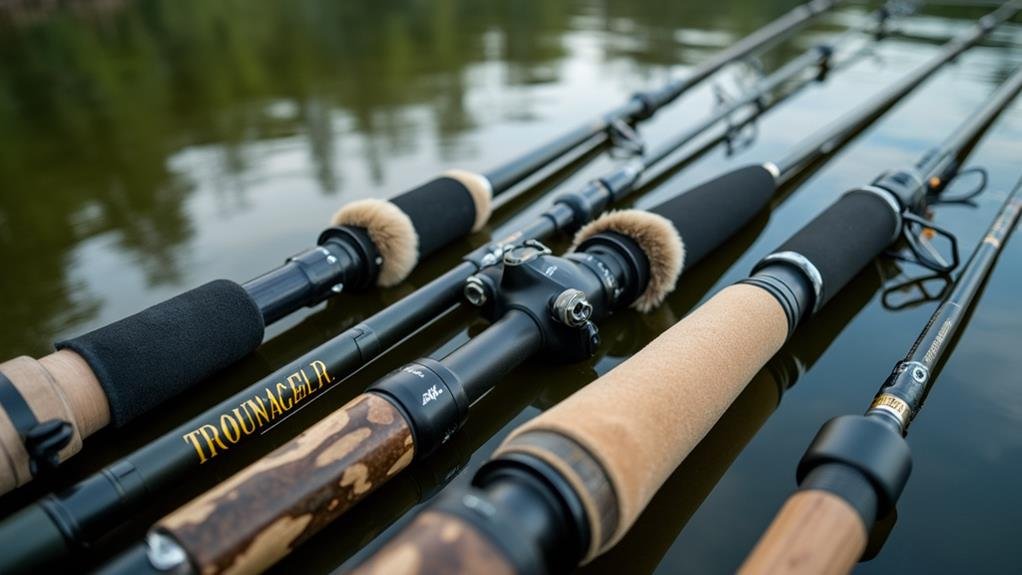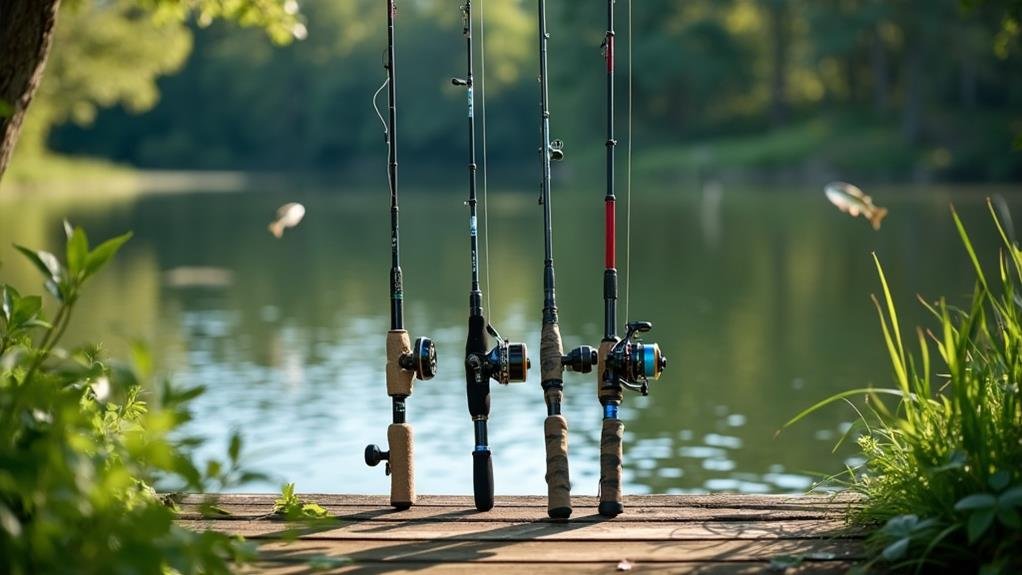If you're looking to improve your bass fishing skills, consider these top rods: the Shimano Curado Casting Rod for its lightweight feel and sensitivity, and the rugged Ugly Stik GX2 that's perfect for beginners. The Abu Garcia Veritas Spinning Rod is ideal if you prefer spinning reels. For flexibility, try the St. Croix Bass X series, available in different lengths and actions. To end, the Fenwick HMG series combines sensitivity with durability. Choosing the right rod can greatly enhance your chances of landing that big catch. Stay tuned for more tips on enhancing your bass fishing experience!
Understanding Freshwater Bass Behavior
Understanding the behavior of freshwater bass is essential for anglers aiming to boost their catch rates. Bass, as opportunistic feeders, thrive in environments where food is plentiful. They typically inhabit areas near structures such as rocks, aquatic vegetation, and submerged timber, which serve as both shelters and hunting zones.
Seasonal shifts significantly impact bass activity. In spring and fall, the increase in metabolic rates leads to heightened feeding opportunities, making these seasons ideal for targeting bass.
The time of day also plays a pivotal role; bass are most active during the early morning and late afternoon hours. During midday, when sunlight penetrates deeply, bass retreat to cooler, deeper waters, making them less accessible. Furthermore, water temperature is a key factor; bass prefer warmer waters, specifically between 65°F and 75°F.
Weather conditions further influence bass behavior. Overcast days often encourage bass to venture out, while bright, sunny days can render them more cautious. Additionally, wind can create surface disturbance, prompting bass to chase after baitfish more actively.
Key Features of Fishing Rods

When you're prepared to cast your line, selecting the appropriate fishing rod can greatly enhance your success in freshwater bass fishing. To begin, evaluate the rod's construction material. Brands like Shimano offer graphite rods that are lightweight and sensitive, ideal for feeling subtle bites. Conversely, fiberglass rods, such as those from Abu Garcia, are more robust and can withstand challenging environments, making them suitable for novice anglers. It's essential to recognize the various categories of freshwater fishing rods tailored to your specific angling requirements.
Next, consider the rod's action. Fast action rods, like those from St. Croix, flex primarily at the tip, which facilitates rapid hook sets. On the other hand, slow action rods bend along their entire length, providing enhanced control when battling a fish. Opt for an action that complements your fishing technique!
Rod length is another vital attribute. A longer rod, such as a 7-foot model from Ugly Stik, allows for increased casting distance, while a shorter rod, like a 6-foot option from Lew's, offers improved accuracy in confined areas. Most bass anglers prefer rods ranging from 6 to 7 feet in length.
Top Freshwater Bass Fishing Rods

Choosing the right fishing rod can greatly influence your bass fishing success. Anglers often rely on reputable brands recognized for their quality and performance. When bass fishing, you need a rod that feels like a part of you. The Shimano Curado Casting Rod excels with its lightweight construction and exceptional sensitivity, making it ideal for various fishing methods. You'll notice even the faintest nibble, enriching your fishing adventure with various accessories.
The Ugly Stik GX2 is another excellent choice. Renowned for its robust build and forgiving action, it suits both novice and experienced anglers. If spinning reels are your preference, consider the Abu Garcia Veritas Spinning Rod. Its responsive design allows for accurate casting effortlessly.
For those who value adaptability, the St. Croix Bass X series provides an array of lengths and actions, enabling you to adjust to different fishing environments. Lastly, the Fenwick HMG series combines sensitivity and durability. Each rod offers unique advantages, catering to diverse fishing styles and preferences. By making an informed decision, you'll feel confident on the water, ready to embrace any bass fishing challenge that lies ahead.
Comparing Rod Materials and Actions

Selecting the right materials and actions for your bass fishing rod can significantly enhance your angling experience. When shopping for a rod, you'll often come across materials like graphite, fiberglass, and hybrid options. Graphite rods are lightweight and highly sensitive, allowing anglers to detect even the faintest bites—an essential feature when using realistic lures like TRUSCEND Fishing Lures. This heightened sensitivity can be crucial when pursuing elusive bass. In contrast, fiberglass rods offer increased durability and flexibility, making them ideal for novice anglers or those fishing in challenging environments.
The action of a rod—its bending characteristics—also plays an important role. Fast-action rods primarily bend at the tip, providing rapid response times for hook sets, which is advantageous when bass strike swiftly. On the other hand, slow-action rods bend more evenly along their length, offering greater flexibility. This forgiving nature can be beneficial when using lighter lines and baits.
Your selection should ultimately align with your unique fishing approach. Consider the specific locations and techniques you employ. The right combination of rod material and action can enhance your time on the water, making your bass fishing adventures even more fulfilling.
Maintaining Your Fishing Rod

Maintaining your fishing rod is essential for keeping it in top shape. Start by cleaning it after every outing. Rinse off any debris or saltwater, and gently wipe the rod with a soft cloth. This straightforward practice prevents corrosion and buildup of grime. Utilizing high-quality fishing lures, like those from PLUSINNO Fishing Lures Baits Tackle, can enhance your fishing trips while also safeguarding your rod from excessive wear.
Next, inspect the line guides and reel seat for any cracks or signs of wear. If you spot any damage, replace those components promptly to avoid more significant issues. When not in use, store your rod in a cool, dry environment. A rod case can offer additional protection during transport.
Don't overlook the reel! Regularly apply oil to the moving parts for smooth operation. Check the drag system and assess the condition of the line. A frayed line can lead to lost catches while fishing.































